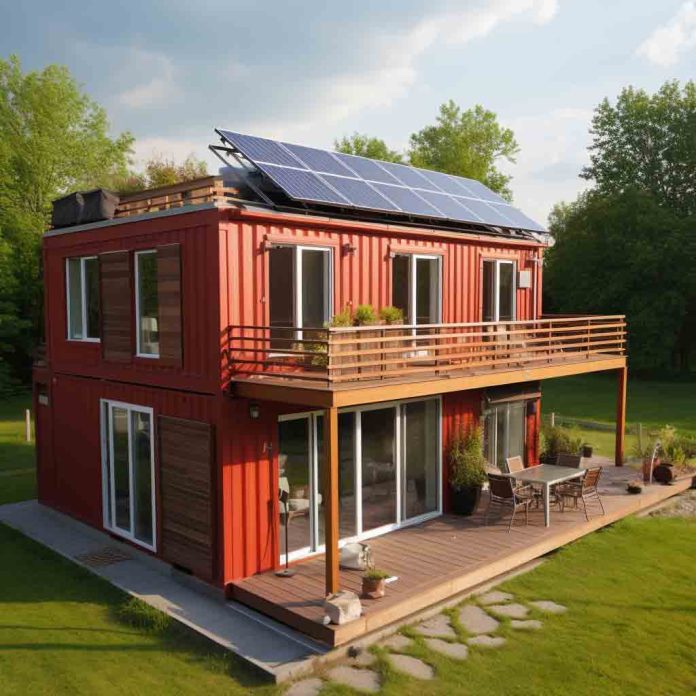How To Insulate a Shipping Container Home: 10 Things You Need To know
As shipping container homes continue to gain popularity for their affordability and sustainability, it’s crucial to address a key aspect of their construction: insulation.
Proper insulation plays a vital role in creating a comfortable living environment, regulating temperature, and maximizing energy efficiency.
In this article, we will explore the ins and outs of insulating a shipping container home, providing you with the knowledge and techniques to create a well-insulated space that is conducive to comfortable living, regardless of the climate.
-
Understanding the Importance of Insulation:
Insulation is crucial for shipping container homes as these structures are primarily made of metal, which conducts heat and cold easily. Without adequate insulation, the interior of the container can become unbearably hot in the summer and excessively cold in the winter. Insulation acts as a barrier, reducing heat transfer and maintaining a comfortable temperature inside the home.
-
Assessing Insulation Needs:
Before starting the insulation process, it’s essential to assess your specific insulation needs. Consider the climate in your region, the intended use of the container home, and your budget. Different insulation materials and techniques are suited for varying climate conditions and desired energy efficiency levels.
-
Choosing the Right Insulation Material:
There are several insulation materials suitable for shipping container homes. Some common options include:
a. Spray Foam Insulation: This type of insulation provides excellent thermal insulation and creates an airtight seal. It adheres to the container’s interior walls and fills gaps, preventing heat transfer effectively. However, professional installation is recommended due to the use of specialized equipment.
b. Fiberglass Insulation: Fiberglass batts or blankets are widely used in traditional construction and can be suitable for container homes. They offer good thermal resistance, are relatively affordable, and can be installed as a DIY project. However, it’s important to ensure proper coverage and seal any gaps to maximize effectiveness.
c. Cellulose Insulation: Made from recycled paper or plant fibers, cellulose insulation is an eco-friendly choice. It provides good thermal performance and can be blown into cavities or installed as loose-fill. Professional installation is recommended for optimal results.
d. Reflective Insulation: Reflective insulation utilizes a reflective surface to redirect heat, making it an effective option for minimizing heat gain in hot climates. It is often combined with other insulation materials to enhance overall performance.
-
Insulating the Container Walls:
Start by thoroughly cleaning the container’s interior walls and addressing any rust or corrosion. Then, install a vapor barrier to prevent moisture buildup. Next, apply the chosen insulation material according to the manufacturer’s instructions. Ensure complete coverage, paying attention to corners, edges, and gaps. Secure the insulation in place, whether using adhesive, staples, or framing.
-
Insulating the Roof and Floor:
Insulating the roof and floor is equally important for maintaining a comfortable living environment. The process is similar to insulating the walls, involving the installation of a vapor barrier and the chosen insulation material. For the roof, consider adding a layer of reflective insulation to minimize heat absorption.
-
Sealing Gaps and Air Leaks:
To maximize the insulation’s effectiveness, it’s crucial to seal any gaps or air leaks in the container. Use caulk, expanding foam, or weatherstripping to seal gaps around windows, doors, electrical openings, and other potential sources of air infiltration.
-
Ventilation Considerations:
While insulation is essential, proper ventilation is equally important to prevent moisture buildup and maintain good indoor air quality. Install vents, fans, or a mechanical ventilation system to ensure adequate airflow without compromising the insulation’s performance.
-
Insulation for Doors and Windows:
Don’t forget to insulate the doors and windows of your container home. Use weatherstripping, insulation tape, or thermal curtains to minimize air leakage and heat transfer.
-
Considering Additional Insulation Techniques:
For extreme climates or enhanced energy efficiency, additional insulation techniques can be employed. These include creating an exterior insulation layer using rigid foam boards, installing a green roof for added insulation and environmental benefits, or utilizing double-wall construction for extra thermal resistance.
-
Regular Maintenance and Monitoring:
Once your shipping container home is insulated, it’s important to conduct regular maintenance and monitor the insulation’s performance.
Check for any signs of damage, moisture buildup, or compromised insulation.
Make necessary repairs promptly to ensure optimal insulation efficiency.
Insulating your shipping container home
Insulating a shipping container home is a vital step in creating a comfortable, energy-efficient living space.
By understanding the insulation needs, choosing the appropriate materials, and employing proper installation techniques, you can enhance the thermal performance of your container home and create an inviting sanctuary regardless of the climate.
Take the time to assess your insulation requirements, consult with professionals when necessary, and invest in quality insulation materials to achieve a well-insulated shipping container home that offers comfort, energy efficiency, and sustainability for years to come.

